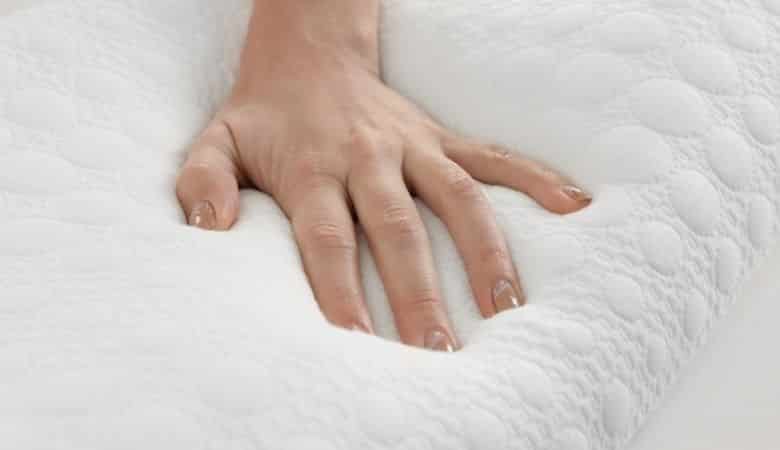Since we spend on average 7-9 hours of our days sleeping, taking some time to learn about a pillow before we decide to buy one is a very smart choice. Having a solid pillow that fits our needs will drastically improve our sleep quality and in doing so also our health and well-being.
In this complete buyers guide, I will guide you through everything you need to know about memory foam pillows. Whether or not memory foam is the right material type for you, if it’s safe to use, provide you with a detailed review of the best memory foam pillows currently on the market and much more.
So, without further ado, let’s get to it.
Why Should You Use a Memory Foam Pillow?
Memory foam pillows are very popular on the market right now, and for good reasons. There are many great benefits of sleeping on memory foam, with the biggest ones being:
- They retain contours, providing great cushioning and support
- They can relieve back and neck pain
- They are energy absorbent
- They accommodates a wide range of sleeping preferences
- They can help reduce snoring
- They are hypoallergenic and hygienic
- They are durable and inexpensive
With that said, like most things there aren’t only benefits, some of memory foams drawbacks include:
- They come with an unpleasent chemical smell
- They retain heat, which can make them hot to sleep on
- They are slow to recover to their original shape
Learn More
If you want to learn more about the benefits and drawbacks listed above, and if a memory foam pillow is for you, you can do so by reading our post Why Should You Use A Memory Foam Pillow? The Pros & Cons
Are Memory Foam Pillows Better Than Regular Pillows?
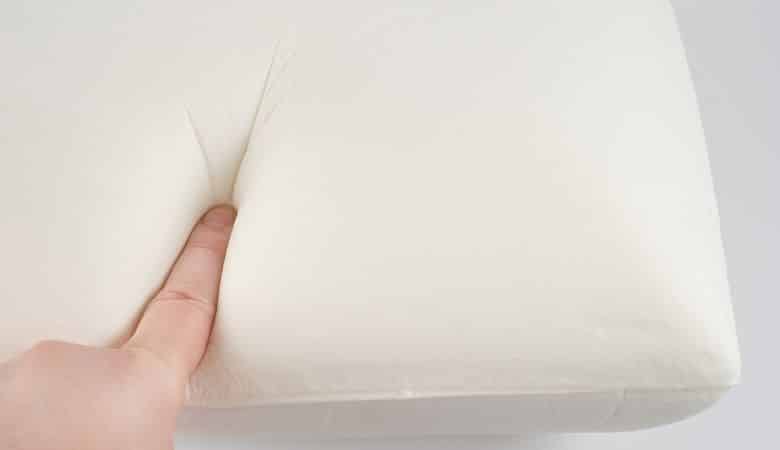
The answer to this question is obviously, “it depends”.
For instance, if you require a lot of support and sturdiness from a pillow, but at the same time won’t have any issues having a pillow that sleeps a bit hot, then a memory foam pillow would be better than a regular pillow for you. Basically, it will depend on your needs and preferences.
Learn More
To help you find out your pillow needs and preferences, we created a post called “Are Memory Foam Pillows Better Than Regular Pillows?”. In the post we provide more in-depth examples for who should and should not use a memory foam pillow.
Are Memory Foam Pillows Safe?
This is a very common question surrounding memory foam. Since memory foam has a somewhat unpleasent chemical smell to it, the logical question is of course if this smell is safe?
Most memory foam pillows that are sold by reputable brands will be safe to use once you get it in your house. There is a short time after the production of memory foam that there might be some health risks associated with the foam.
Newly manufactured memory foam goes through something called “the off-gasing period”, where the material essentially off-gases certain carcinogens that was used in the production of the memory foam. Once the foam has been through this period it’s considered safe to use. Afterall, If it weren’t, it wouldn’t be allowed for sale.
Learn More
If you want to read more about the safety of memory foam, read our post “Are Memory Foam Pillows Safe? Is The Smell Toxic or Not?“
How Often Should You Replace Memory Foam Pillows?
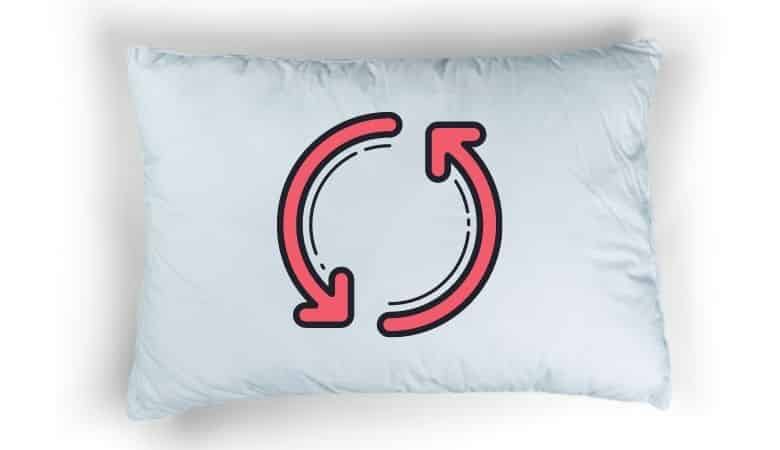
One big advantage of memory foam is that it’s a fairly durable material. This means that if you decide to go with a memory foam pillow you will not need to replace it as often as pillows made from certain other materials. Experts and manufacturers seems to agree that a memory foam pillow will last for about 36 months on average.
However, just because sleep experts say your memory foam pillow will last 36 months does not mean you should use it that long. How often you replace your pillow will depend on your personal preference, use, body weight, among other factors.
You will probably want to replace your memory foam pillow once you experience some of the following things:
- You notice your foam has some lumps on it
- Your pillow needs constant fluffing up, so it supports your head better
- The sweat and body oil stains on the pillow are permanent
- When you fold it into half, it doesn’t restore itself to its original shape but stays folded
- You regularly wake up with neck and shoulder pains
- If you have allergies, they have worsened. If not, you start experiencing allergy symptoms
- You toss and turn a lot at night trying to find a good sleeping position
- Sometimes, you wake up feeling tired and with a stinging headache
Learn More
If you want to read more about how often to replace memory foam pillows, check out our post “How Often Should You Replace Memory Foam Pillows?“
How to Clean a Memory Foam Pillow
If you already own a memory foam pillow or if you decide to buy one, you’ll probably wonder how to clean it. Afterall, cleaning your pillow will make it last longer, which means you won’t need to replace your pillow(s) as often.
Now, there will be different reasons behind needing to clean your pillow, these stretch from regular maintenance/cleaning to removing tough spills.
Learn More
Read our post “How to Clean a Memory Foam Pillow: Step by Step Guide” and follow the steps underneath the headline behind your specific reason for cleaning.
Can Memory Foam Pillows Grow Mold?
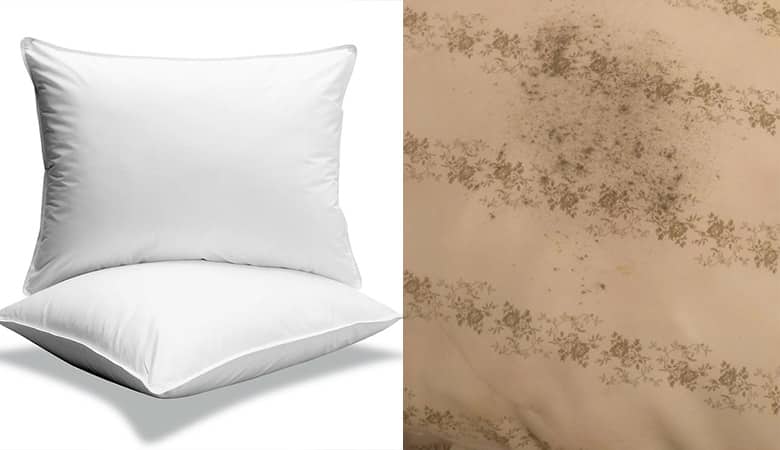
A somewhat common question that people has is whether or not memory foam pillows can grow mold. Furthermore, a big reason why many people decide to buy memory foam pillows is that they believe that they can’t grow mold. Well, sadly they can.
The thing is that mold thrives in wet, moist environments, so if your pillow is in such a state, it will get moldy even though it’s made of memory foam. With that said, memory foam doesn’t retain water as easily as other materials, so it’s harder for mold to grow on/in a pillow made out of memory foam as compared to one made out of down or polyester for instance.
Learn More
If you want to read more about why mold growth occur, how to avoid it, and how to remove mold if your memory foam pillow has become moldy, check out our post “Can Memory Foam Pillows Grow Mold? And How to Avoid it!“
How to Dry a Memory Foam Pillow
Okay, so you know how to clean your memory foam pillow, but how about drying it?
Drying your pillow correctly is important if you want to avoid lying down on a moisty pillow, which could lead to mold growth further down the line.
There are two different approaches to correctly drying a memory foam pillow, and these are 1) drying your pillow without a dryer and 2) drying your pillow with a dryer. Let’s look at these two approaches step by step:
How to dry your memory foam pillow without a dryer:
- Your memory foam pillow will hold a lot of water after it’s been washed. Gently squeeze to remove excess water. Take your time and be very gentle to prevent damage to your pillow. Do not wring out the memory foam!
- Air is the key to drying the pillow. Set the memory foam pillow outside in the sunlight for at least four hours. Make sure the surface you lay it on is clean and has no potential for stains or spotting. If you have a clothesline available, that would be a perfect place to have it dry out from. The sun will heat the pillow and dry it out.
- If the pillow needs to be air dried from indoors, place it in a well-ventilated room and either let it hang dry, or lay it out as referenced in step 2. If possible, open nearby windows and doors. You may also wish to place a fan near the pillow to help it along.
- Flip or turn the pillow often. If the pillow is hanging out to dry, check it every couple of hours and turn it to make sure both sides get a touch of the sun, if possible. If the pillow is laying flat, check it every couple of hours and flip it over to make sure both sides are drying equally. This is a process you will need to repeat several times as it will take some time for the pillow to completely dry.
- Allow the pillow to dry completely. Check the pillow before using it by pressing the foam between your hands to feel for moisture. If moisture remains, repeat from step 2. It’s very important to make sure the pillow has completely dried to avoid bacteria or mildew build-up.
How to dry your memory foam pillow with a dryer:
- Do not place more than two pillows in the dryer at the same time. More than two pillows could overload the dryer; pillows expand after drying.
- Set the dryer to the lowest heat/no heat setting or the tumble dry setting for a dry cycle.
- Place tennis balls into white socks and throw them in the dryer with the pillows. The balls will bounce around in the dryer and keep the filming from clumping when the pillow starts drying, and the pillow will come out fluffy. The balls are placed in socks to prevent lint from forming on the pillow.
- The pillow will need to run through several cycles (45 minutes at a time) before it’s completely dry. After each cycle, take the pillow out of the dryer and shake it to avoid clumping. This also helps to get it fluffy.
- After the pillow has gone through several cycles, check for moisture by squeezing it to feel if it’s entirely dry. If it’s dry, great! You’re all done. If not, continue to run the dryer until the pillow is completely dry.
Learn More
Read our post “How to Dry a Memory Foam Pillow: Step by Step Guide” to learn more about trying your memory foam pillow.
Should You Put a Pillowcase on Your Memory Foam Pillow?
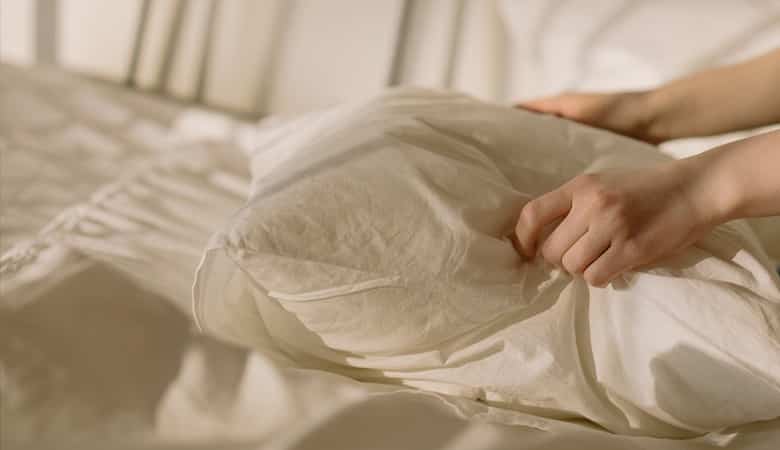
A lot of people wonder whether or not they should put a pillowcase on their memory foam pillow. The reason for this question is that since memory foam is so adaptive to the contours of your body, wouldn’t putting a pillowcase on it remove this property?
The answer to this question is that it depends a lot on the type of pillowcase that you choose. To maintain the properties of memory foam, using a pillowcase with a stretchy material is adviced as this will allow the memory foam to work its magic.
By using a stretchy pillowcase on your memory foam pillow you will also get the following advantages:
- Makes it much easier to wash
- Can regulate temperature better
- Naturally hypoallergenic, great if you are sensitive to certain fabrics
- Additional comfort
Learn More
If you’d like to read more about the advantages of putting a pillowcase on your memory foam pillow, check out our post “Should You Put a Pillowcase on Your Memory Foam Pillow?“
Why Are Memory Foam Pillows so Hard?
This is a very common question, especially from people who haven’t slept on a memory foam pillow yet, but only tried it out for a brief time.
The fact is that memory foam pillows will feel hard at first, when the foam is cold. The viscosity of the foam are designed to adapt to the shape of your head and neck once your body heat softens up the foam. This leads to great support and comfort for all sleeping positions.
Learn More
Read our post “Why Are Memory Foam Pillows so Hard? How to Soften Them!” to learn more about the properties of memory foam, why these pillows are hard at first and how to soften them up.
The Best Memory Foam Pillows Currently on The Market
Okay, so you’ve come to the end of this guide and perhaps you’ve learned that a memory foam pillow is exactly what you need. If that’s the case, we created a full guide and review of the best memory foam pillows currently on the market.
Learn More
If you are interested in an unbiased review of the best memory foam pillows currently available, you can check out that post here.

